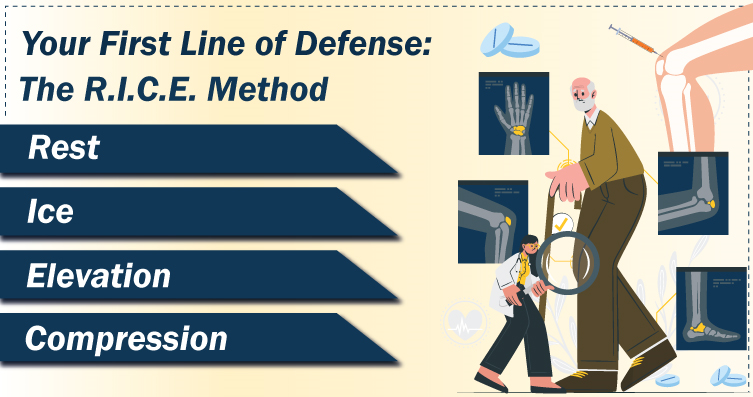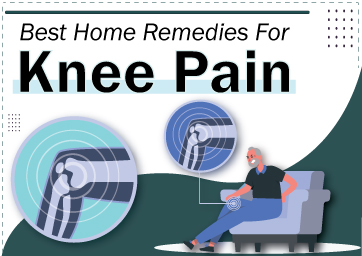Anyone, not just the elderly, can experience
sudden knee pain. Try to follow these simple home care tips for immediate knee pain treatment at home. Consult an
expert if the pain doesn't go away within 24-48 hours.
A. Your First Line of Defense: The R.I.C.E.
Method

Step 1: Rest
Pain is your body's way of alerting you that
something is wrong and that you should be cautious. Stop any activity that
reiterates the pain in your knees.
It's difficult to know how serious an injury
or strain is right away.
As a result, if you choose not to rest, you
risk exacerbating the illness and delaying your recovery.
Step 2: Ice
Ice is a natural pain reliever. Applying an
ice pack to the pain site lessens pain and inflammation by reducing blood flow.
Also, stiffness is less likely to occur when you use ice.
Ice is most effective when applied within the
first 24 hours of the onset of knee pain. Apply an ice pack (wrapped with a
light, absorbent towel) for 15-20 minutes every two to three hours for the
initial two days.
Step 3: Compression
Wrap a medical bandage around the painful
area. It will help to prevent swelling. Don't wrap the bandage too tightly, or
it will restrict blood flow. If the skin under the dressing turns blue or feels
cold, numb, or tingly, loosen it.
Step 4: Elevation
Lying down with your knee raised and supported
on pillows can help lessen pain and swelling. Raising a painful body part above
your heart reduces throbbing, swelling, and discomfort. Even if you're not
using an ice pack on the injured area, you should keep it elevated as much as
possible.
B. Over-The-Counter Medications
If you can move your knee after a few hours
and the pain is mild, you can use generic pain medicines such ibuprofen (Advil,
Motrin I.B., and others) or naproxen sodium (Aleve).
If you're wondering how to relieve knee pain at night, the measures above and pain
relievers will be highly beneficial. It will help you alleviate discomfort and
sleep well.
C. Other Secondary Remedies
While the solutions listed above will provide
quick relief, there are more long-term knee pain relief options. You can use
the bottom remedies for knee pain
treatment at home.
1. Exercise
There is no better way to increase your knee
strength and mobility than exercise. Exercise is used to cure osteoarthritis,
tendonitis, meniscus tears, and damaged knee ligaments, among other frequent
causes of knee pain.
You can also try Tai-Chi if you're searching
for a less rigorous alternative. It is a mind-body exercise that improves
balance and flexibility.
Tai chi can aid in the reduction of pain and
improve mobility. Deep breathing and relaxation are also involved. These
elements may also help you manage chronic pain and reduce stress.
2. Weight Management
Obesity increases the risk of chronic diseases
such as high blood pressure, diabetes, and high cholesterol. However, did you
realize that carrying excess weight puts extra strain on your knees?
While one may not realize it initially, extra
weight can cause chronic pain. Even a 5 kg increase in weight can put another
30-60 pounds of pressure on your knees. If you're overweight and experiencing
knee pain, decreasing weight may help relieve the pressure.
3. Hot and Cold Therapy
Heat relieves pain and muscle spasms. If you
are experiencing only pain and there is no swelling, it's OK to apply a heating
pad to the pain area.
However, if there is swelling, apply ice for
24 hours before switching to heat.
Follow these tips to carefully use heat and
cold therapy:
●
Never apply heat for more than 20 minutes to the affected area.
Check that the heating pad isn't too hot before using it.
●
If the affected area is damaged or swollen, don't use heat
therapy. Instead, take a warm shower in the morning to relax stiff joints.
●
For the first two days, apply cold pads for 20 minutes. Never
apply ice directly to the skin.
●
Switch between cold and hot therapies 3-6 times a day.
4. Use Alternative Medicine
Alternative medicine has been in practice for
centuries now. However, no substantial scientific research or study backs up
its efficacy in pain reduction.
Traditional alternative medicine may include:
●
Ayurveda
●
Naturopathy.
●
Acupuncture.
●
Homeopathy.
●
Chinese or Oriental medicine.
If you are using medications for some
underlying health condition or chronic pain, consult your doctor once before
trying any of the above remedies.
5. Consider Using Knee Supports
Knee braces offer support to the area of the knee
experiencing pain. A knee brace is also very effective for everyday activities
like standing and walking. Even if the pain is severe, a knee brace is more
than handy to relieve pain and improve mobility.
However, you should seek advice from a professional
before using it. There are different types of knee supports and braces. You
should choose the one that best serves your needs.



 Contact Us
Contact Us






 Hospitals
Hospitals
 Doctors
Doctors
 Diagnostic
Diagnostic
 Pharmacy
Pharmacy
 Health Tips
Health Tips
 Blog
Blog


























Comments